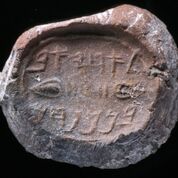
First Temple Era Engravings Discovered In Jerusalem
Jerusalem archeologists will display to the public a rare collection of seals (bullae) from the First Temple period at a conference in Jerusalem this week, the Israeli Antiquities Authority announced on Monday.
Ortal Chalaf and Dr. Joe Uziel, directors of the excavation for the Israel Antiquities Authority, said dozens of ancient seals were unearthed in the City of David, adjacent to the Dung Gate of the Old City of Jerusalem. They said the finds bear witness to the developed administration of the city in the First Temple period.
“The earliest seals bear mostly a series of pictures,” the archeologists said in a joint statement. “It appears that instead of writing the names of the clerks, symbols were used to show who the signatory was, or what he was sealing. In later stages of the period – from the time of King Hezekiah (around 700 BCE) and up to the destruction of Jerusalem in 586 BCE – the seals bear the names of clerks in early Hebrew script.
“Through these findings, we learn not only about the developed administrative systems in the city, but also about the residents and those who served in the civil service,” they said.
The bullae are small pieces of clay which in ancient times served to seal letters. A letter which arrived with its seal broken was a sign that the letter had been opened before reaching its destination. Although letters themselves did not survive the terrible fire which consumed Jerusalem at its destruction, the seals, being made of clay, were actually well-preserved thanks to the fire, and attest to the existence of the letters and their senders.
Some of the seals bear biblical names. One mentions a man by the name of “Achiav ben Menachem.” These two names are well-known in the context of the Kingdom of Israel: Menachem was a king of Israel, while Achiav does not appear in the Bible, but his name resembles that of Achav (Ahab), the infamous king of Israel described in the Book of Kings.
Chalaf and Uziel added that the appearance of the name Achav gives us a window into the names used during the Biblical era, and which appear in Judea during the period following the destruction. They noted that the two names which appear on the seal – Achav and Menachem- were names of kings of Israel.
“These names are part of the evidence that after the exile of the Tribes of Israel, refugees arrived in Jerusalem from the northern kingdom, and found their way into senior positions in Jerusalem’s administration,” the statement said.